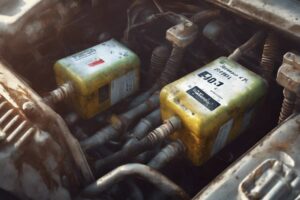Seeing a P0456 code pop up on your dashboard might initially seem minor, but it’s actually a heads-up about a small leak in your car’s evaporative emission system. Ignoring it could lead to bigger problems later, so it’s smart to tackle it early.
This issue is all about preventing vapors from the fuel system from escaping into the atmosphere, and a leak can mess with that process. I’ll guide you through spotting common leak points and fixing them with ease.
Understanding the P0456 Code
When diagnosing the P0456 code in your vehicle, you’re identifying a common issue related to small leaks in the evaporative emission system.
Diagnostic procedures for this code involve utilizing a scan tool to check for any trouble codes present in the system.
Additionally, a smoke machine test can be conducted to pinpoint the exact location of the leak. This test involves introducing smoke into the system and observing where it escapes.
Common causes of the P0456 code include loose or damaged gas caps, cracked hoses, or faulty purge valves.
To effectively diagnose the P0456 code, it’s crucial to inspect all components of the evaporative emission system thoroughly.
Begin by visually inspecting the gas cap for any signs of wear or damage. Check the hoses connected to the system for cracks or leaks.
Ensure that the purge valve is functioning correctly by testing its operation. By following these diagnostic procedures and addressing the common causes, you can successfully resolve the small leaks causing the P0456 code in your vehicle.
Locating Common Leak Points
To effectively identify common leak points in your vehicle’s evaporative emission system, focus on inspecting key components such as the gas cap, hoses, and purge valve.
When conducting leak detection for your evaporative system maintenance, pay close attention to the following areas:
- Gas Cap: Check the gas cap for any signs of wear, cracks, or looseness. A faulty gas cap can lead to leaks in the evaporative system, triggering the P0456 code.
- Hoses: Inspect all hoses connected to the evaporative system for cracks, holes, or loose connections. Leaks often occur in these hoses due to age or damage from road debris.
- Purge Valve: The purge valve is a crucial component in the evaporative emission system. Ensure it’s functioning correctly and not stuck open or closed, causing leaks in the system.
Tools Needed for Repairs
For efficient repairs on your evaporative emission system, having the right tools is essential to ensure accurate diagnosis and effective solutions.
When working on small leaks in the evaporative emission system, a set of tools will aid you in pinpointing the issues and resolving them efficiently.
The primary tools you’ll need include a smoke machine, scan tool, multimeter, and a handheld vacuum pump with gauge.
Proper tool maintenance is crucial to ensure their effectiveness during repairs. Keep your smoke machine clean and free of debris to prevent false readings. Regularly calibrate your multimeter to maintain accuracy in voltage, current, and resistance readings. Store your scan tool in a cool, dry place to prevent damage to its electronic components.
Troubleshooting tips for using these tools include following manufacturer instructions carefully, checking for software updates for your scan tool, and practicing proper safety precautions when working with electrical equipment.
By maintaining your tools and following troubleshooting tips, you can efficiently diagnose and fix small leaks in your evaporative emission system.
Step-by-Step Repair Instructions
To start fixing small leaks in your evaporative emission system, begin by locating the source of the leak using a smoke machine and checking for any visible signs of damage or wear.
Once you have identified the leak, follow these repair techniques and troubleshooting tips:
- Inspect and Replace: Check all hoses, connectors, and the gas cap for cracks, holes, or loose fittings. Replace any damaged components with new ones to ensure a proper seal.
- Tighten Connections: Make sure all connections in the evaporative emission system are securely fastened. Use appropriate tools to tighten any loose fittings to prevent leaks.
- Clear Obstructions: Inspect the purge valve and canister for any debris or blockages that could be causing the leak. Clean out any obstructions carefully to allow for proper functioning of the system.
Testing and Clearing the Code
After identifying and fixing the small leaks in your evaporative emission system, the next step involves testing and clearing the diagnostic trouble code associated with the issue. Code diagnosis is crucial in ensuring that the problem has been completely resolved.
To begin, you’ll need an OBD scanner, a tool that can communicate with your vehicle’s onboard computer to retrieve trouble codes. Connect the OBD scanner to the diagnostic port typically located under the dashboard. Follow the scanner’s instructions to read the trouble code stored in the system.
If the repair was successful, you can proceed to clear the code using the OBD scanner. This step will reset the check engine light and ensure that the issue has been addressed.
After clearing the code, it’s advisable to perform a final check to confirm that the code doesn’t reappear, indicating a successful repair of the evaporative emission system.
As an Amazon Associate we earn from qualifying purchases.










